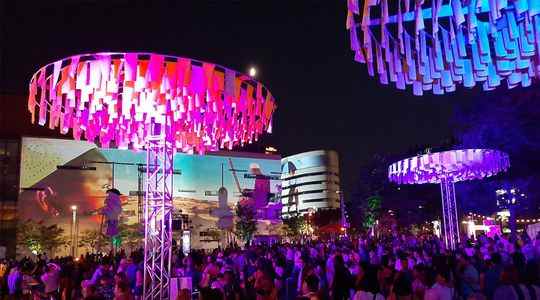The Montreal night beats to the rhythm of Afro-futurism. Originally from Congo, Senegal, Ivory Coast or South Africa, musicians and DJs resonate with the sounds of afrohouse and afrobeat, gqom and amapiano. So many genres that reinvent ancestral dance rhythms in the age of computer-assisted music and evolve without limits in the great artistic broth of the Quebec metropolis.
Architect of this movement, the musician Pierre Kwenders comes alive when asked what his adopted city has more than Paris, London or New York. “The beauty of Montreal is that here everyone collaborates with everyone. There is total fluidity between artists of African origin and those born in Quebec or elsewhere.” To be convinced of this, just listen to his latest album, José Louis And The Paradox of Love (2022), where we meet both the leader of Arcade Fire, Win Butler, and the Breton singer Sônge, and where the influence of both Prince and Papa Wemba are felt. Lingala lyrics blend with English and French. Either a real precipitate of Montreal cosmopolitanism.
From parties at home… to festivals around the world
Arrived in Canada in 2001, the native of Kinshasa however initially encountered resistance. “For us, it was the heyday of the coupé-décalé, which was not represented at all in the clubs, where hip-hop and techno reigned supreme. So we started to organize parties at the house … who soon overstepped the bounds of the diaspora.” Moonshine, the name of the organizing collective founded in 2014 by Kwenders and his manager Hervé Kalongo, is today a key for revelers in search of strong vibrations. “I had just released my first album and I was scheduled for the Transmusicales in Rennes, but we had no money to tour. So we organized a party on a full moon Saturday. For the premiere, we had invited 150 people, and 300 came,” he recalls.
The success is such that Moonshine is exported around the world (from Lisbon to Los Angeles). He even gave birth to a label and a clothing line (moonshine.mu/). And all the artists of the diaspora benefit from this dynamic. Whether they are called Møziz, Karyke, NoKliché, De. Ville, Afrikana Soul Sister or Pierre Kwenders, we can count on them to never let Montreal fall asleep.
Three now unmissable events
The international festival Nuits d’Afrique
Pierre Kwenders is formal: “We can’t talk about music in Montreal without mentioning Nuits d’Afrique.” Founded by Lamine Touré in 1987, the festival brings together 32,000 spectators each year. Among the rooms invested, we find the Balattou, the bar where it all started. “Even today, young artists from the diaspora make their debut there. The Balattou is a monument, it is the soul of Nuits d’Afrique.”
The Mural Festival
Created in 2012, this festival celebrates the democratization of urban art in Montreal. Between boulevard Saint-Laurent, rue Sherbrooke and avenue du Mont-Royal, we come to admire the works of the most prominent street artists, but also to listen to concerts and DJ sets with a desired openness to Africa. Moonshine also offers this year “a line-up representing the most current African sounds”.
Underground parties
“Montreal loves underground parties,” assures Pierre Kwenders. Translation: the more an event is secret, hidden, select, the more it attracts partygoers. Moonshine is of course the model with its “SMS for location” policy (the location is only revealed by SMS on D-Day). In the same spirit, we will watch for the events of the Afrotronik collective and the Mansa & Friends evenings of the DJ Mansa Musso.
